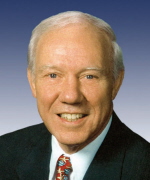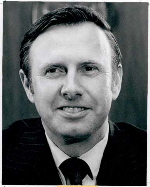The Still Very Long Odds of an Oberstar (or Walz) Defeat in November
Less than 4 percent of Minnesota U.S. House incumbents have been defeated out of more than 200 who won at least 60 percent of the vote during the previous election cycle

In Walz’s case, a SurveyUSA poll released last week found the two-term incumbent with only a 47 to 42 percent advantage over Republican state Representative Randy Demmer.
For Oberstar, the hullabaloo came not from a public poll but from one conducted by a GOP pollster, funded by the campaign of his challenger, Chip Cravaack.
Both polls provoked significant statewide and national interest in these Minnesota races, with several D.C. prognosticators shifting their ratings of these congressional seats to more competitive as a result.
Tim Walz’s seat is now rated as ‘leans Democrat’ by both Congressional Quarterly and the Cook Political Report, while Larry Sabato’s Crystal Ball and the Rothenberg Political Report rate it one notch safer for the incumbent (‘likely Democrat’ and ‘Democratic favored’ respectively).
Jim Oberstar’s district, which had previously not been on any of the analysts’ chalkboards of seats in play in 2010, is now rated as ‘likely Democrat’ by Congressional Quarterly and Cook Political Report and the Rothenberg equivalent of ‘Democratic favored.’
But if these two seats are in fact ‘in play,’ what are the odds they could actually flip on November 2nd, even in a Republican wave election year?
Smart Politics analyzed each of the more than 550 general election Minnesota U.S. House matchups conducted since statehood and finds there is only scarce historical precedence that either Oberstar or Walz can be defeated in 2010.
Overall, incumbents have appeared on the general election ballot in 487 out of 552 U.S. House races in the Gopher State, winning 425 of these, or 87.3 percent of the time.
But the fact there is an incumbency advantage in Congressional elections is not news.
Oberstar and Walz, however, are not ordinary incumbents.
Oberstar won his 18th term with 67.7 percent of the vote in 2008, while Walz won his second term with a nearly as impressive 62.5 percent.
Why is this important?
Only 8 of 203 Minnesota U.S. House incumbents have been defeated in the general election after receiving at least 60 percent of the vote during the previous election cycle, or just 3.9 percent.
(Note: the data above excludes four incumbents who were defeated during the 1932 election, in which the Gopher State elected all nine Representatives to the U.S. House as at-large representatives. This resulted in 32 candidates appearing on the ballot for nine seats, with the winning representatives carrying only between 4.0 and 5.0 percent of the vote. Six Republicans who had won election in 1930 were defeated, with four of these having earned more than 60 percent of the vote in their respective district races).
So what does this mean for the prospects of a GOP upset in MN-01 or MN-08 in 2010?
For starters, it means Minnesota Congressmen who reach the 60 percent plateau are more than five times less likely to get defeated at the ballot box (3.9 percent) than those incumbents who fall short of the 60 percent mark (21.1 percent).
For Oberstar, the numbers are even more striking.
Only one incumbent in Minnesota history has ever been defeated after winning as large a percentage as Oberstar’s 67.7 percent tally during the previous election cycle.

In 1982, Arlen Ehrdal was out-districted from the 1st to the 6th district, and saw his 71.8 percent vote total in 1980 over DFLer Russell Smith fall to just 49.2 percent in defeat to DFLer Gerry Sikorski, running in a district with many new faces.
For Walz, who won 62.5 percent of the vote in 2008, this means only four incumbents in history have ever been defeated after winning as large a percentage of the vote as he did during the previous election cycle: Erdahl (71.8 percent in 1980), Republican Melvin Maas (65.1 percent in 1942), Sikorski (64.6 percent in 1990), and Republican James McCleary (64.1 percent in 1904).
In short, the vast majority of the already small universe of incumbents who have been defeated at the ballot box were not nearly as successful as Oberstar or Walz during the previous election cycle – averaging just 53.1 percent of the vote overall.
This means many of these incumbents were already involved in competitive races just two years prior to their defeat:
· Three incumbents had not won even 40 percent of the vote
· Another 10 incumbents earned between 40 and 50 percent of the vote
· Nearly three-dozen incumbents earned between 50 and 60 percent of the vote.
And of those eight incumbents who were defeated after earning at least 60 percent of the vote, half had to run during a year with brand new district lines (years ending in ‘2’): Erdahl in 1982, Republican Loren Fletcher in 1902, Republican Walter Judd in 1962, and Sikorski in 1992.
Of course, it is unlikely Walz will let up on the accelerator during the final two weeks of the campaign as he tries to stave off Randy Demmer. Two years prior to Walz’s defeat of GOPer Gil Gutknecht in 2006, Gutknecht had notched 59.6 percent of the vote, or about three points shy of Walz’s 2008 tally.
Percentage of Vote Received by Minnesota U.S. Representatives During the Election Cycle Prior to Defeat
|
Year
|
U.S. Rep.
|
Party
|
Terms
|
Percent
|
|
1982
|
Arlen Erdahl*
|
GOP
|
2
|
71.8
|
|
1944
|
Melvin J. Maas
|
GOP
|
8
|
65.1
|
|
1992
|
Gerry Sikorski
|
DFL
|
6
|
64.6
|
|
1906
|
James T. McCleary
|
GOP
|
7
|
64.1
|
|
1962
|
Walter H. Judd
|
GOP
|
10
|
60.9
|
|
1868
|
Ignatius Donnelly
|
GOP
|
3
|
60.8
|
|
1982
|
Tom Hagedorn**
|
GOP
|
4
|
60.6
|
|
1954
|
Harold C. Hagen
|
GOP
|
6
|
60.5
|
|
2006
|
Gil Gutknecht
|
GOP
|
6
|
59.6
|
|
1902
|
Loren Fletcher
|
GOP
|
5
|
59.4
|
|
1948
|
Harold Knutson
|
GOP
|
16
|
57.4
|
|
1920
|
William L. Carss
|
Democrat
|
1
|
57.1
|
|
2000
|
David Minge
|
DFL
|
4
|
57.0
|
|
1926
|
Knud Wefald
|
Farmer-Labor
|
2
|
56.8
|
|
1938
|
John T. Bernard
|
Farmer-Labor
|
1
|
56.4
|
|
1928
|
William L. Carss
|
Farmer-Labor
|
3
|
55.4
|
|
1990
|
Arlan Stangeland
|
GOP
|
7
|
54.6
|
|
1890
|
Samuel P. Snider
|
GOP
|
1
|
53.8
|
|
1892
|
William H. Harries
|
Democrat-Farmer’s
|
1
|
53.6
|
|
1896
|
Charles A. Towne
|
Democrat-People’s
|
1
|
53.3
|
|
1886
|
John B. Gilfillan
|
GOP
|
1
|
53.2
|
|
1890
|
Solomon G. Comstock
|
GOP
|
1
|
52.7
|
|
1958
|
Coya Knutson
|
DFL
|
2
|
52.7
|
|
1922
|
Halvor Steenerson
|
GOP
|
10
|
52.6
|
|
1878
|
Horace B. Strait
|
GOP
|
2
|
52.5
|
|
1888
|
Edmund Rice
|
Democrat
|
1
|
52.4
|
|
1888
|
Thomas Wilson
|
Democrat
|
1
|
52.0
|
|
1946
|
William A. Pittenger
|
GOP
|
7
|
51.9
|
|
1946
|
Frank T. Starkey
|
DFL
|
1
|
51.8
|
|
1966
|
Alec G. Olson
|
DFL
|
2
|
51.8
|
|
1892
|
James N. Castle
|
Democrat
|
1
|
51.8
|
|
1918
|
Clarence B. Miller
|
GOP
|
5
|
51.6
|
|
1960
|
Roy W. Wier
|
DFL
|
6
|
51.6
|
|
1948
|
Edward J. Devitt
|
GOP
|
1
|
51.5
|
|
1948
|
George MacKinnon
|
GOP
|
1
|
51.5
|
|
1890
|
Darwin S. Hall
|
GOP
|
1
|
51.4
|
|
1970
|
Odin Langen
|
GOP
|
6
|
51.2
|
|
1890
|
Mark H. Dunnell
|
GOP
|
6
|
50.4
|
|
1888
|
John L. MacDonald
|
Democrat
|
1
|
50.3
|
|
1880
|
Henry Poehler
|
Democrat
|
1
|
50.0
|
|
1938
|
Paul John Kvale
|
Farmer-Labor
|
5
|
49.7
|
|
2002
|
Bill Luther***
|
DFL
|
4
|
49.6
|
|
1944
|
Richard P. Gale
|
GOP
|
2
|
49.0
|
|
1938
|
Dewey W. Johnson
|
Farmer-Labor
|
1
|
47.8
|
|
1922
|
Andrew J. Volstead
|
GOP
|
10
|
47.5
|
|
1938
|
Henry G. Teigan
|
Farmer-Labor
|
1
|
46.3
|
|
1940
|
John G. Alexander****
|
Ind-Republican
|
1
|
45.3
|
|
1894
|
Osee M. Hall
|
Democrat
|
2
|
44.8
|
|
1940
|
Elmer J. Ryan
|
Democrat
|
3
|
43.6
|
|
1894
|
Melvin R. Baldwin
|
Democrat
|
1
|
43.4
|
|
1914
|
Frederick C. Stevens
|
GOP
|
9
|
36.8
|
|
1936
|
William A. Pittenger
|
GOP
|
3
|
35.7
|
|
1894
|
Haldor E. Boen
|
People’s
|
1
|
35.6
|
|
|
Average
|
|
3.6
|
53.1
|
* Arlen Erdahl was outdistricted from the 1st to the 6th District in 1982. ** Tom Hagedorn was outdistricted from the 2nd to the 1st District in 1982. *** Bill Luther was outdistricted from the 6th to the 2nd District in 2002. **** Republican John Alexander failed to win the nomination of his Party so ran on the Independent-Republican ticket instead. Data excludes the seven incumbents in state history who have been defeated in at-large elections (in 1859 and 1932) as well as the two incumbents defeated in a district race in 1934 after having been elected in a statewide election (in 1932). Data compiled by Smart Politics.
Follow Smart Politics on Twitter.

History is history … the landscape is different today.
Take Walz’s victory in 2008 when he won every county … including some extremely reliable Republican counties … why ? … Your options : Republicans learned to love Tim Walz or, Dr. Brian Davis was such a weak candidate ? Plus, the DFL fielded candidates in every contest … this year there are a few elections where only the MN-GOP is on the ballot ( for example Julie Rosen represents the strong Republican SD-26 district and Paul Torkelson in HD-21-B are unopposed.) Another factor is that in 2008, there was only two candidates on the ballot … this time there are four with Independence Party candidate polling at 5% and has participated in a few debates.
IMO, Walz is in a tight race … the outside money is pouring in … and television commercials are relatively inexpensive in Mankato (which broadcasts into the heart of the Republican strength.)
IMO, making both Oberstar and Walz targets should actually help the DFL and Mark Dayton … he needs strong support from the Iron Range and to win Rochester … by flooding the airwaves with anti-Democrat commercials should counter the apathy that the DFL could have experienced.
Lastly, I expect both incumbents to win, but not nearly by their previous margins … including Walz getting less than 50%. Tom Horner effect could be quite strong providing coattail voting for the IP Congressional candidates … watch HD 24-B for the IP Mark Meyer to garner more votes than the DFL candidate Joan Muth-Milks (where Tony Cornish (MN-GOP) is the incumbent).